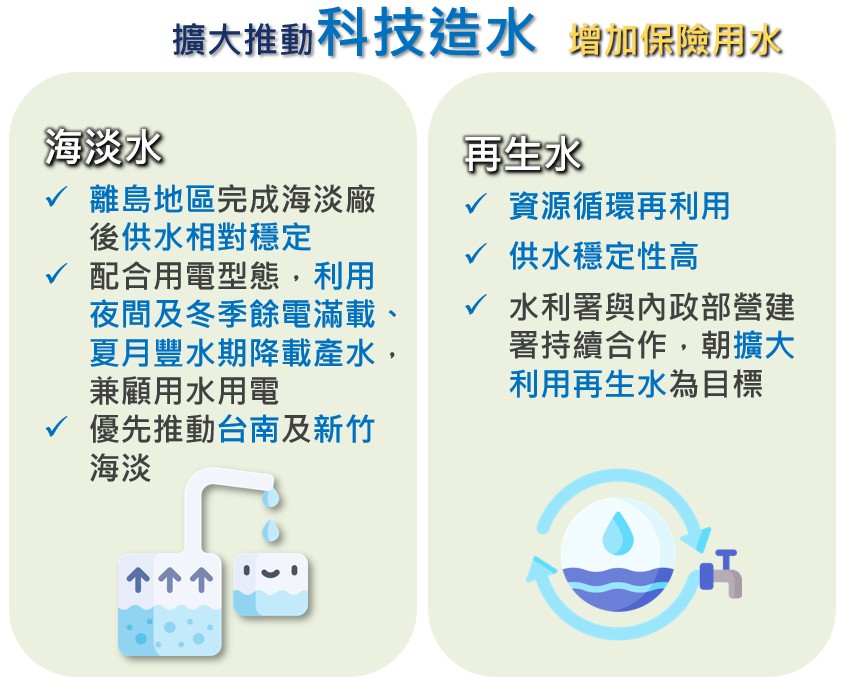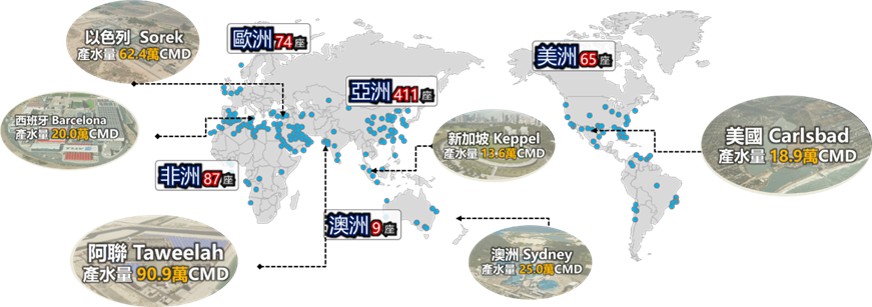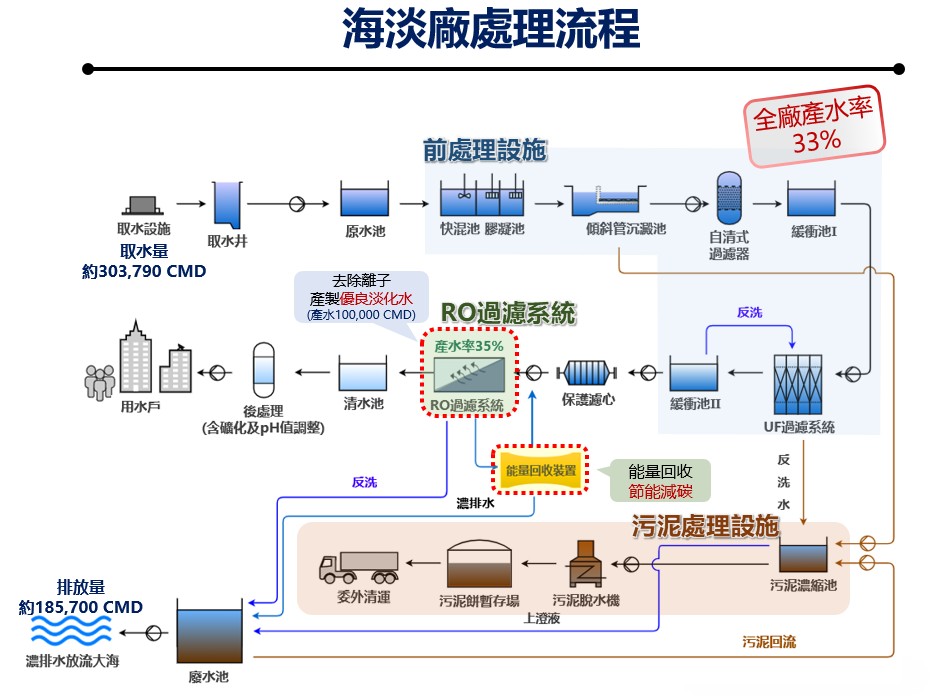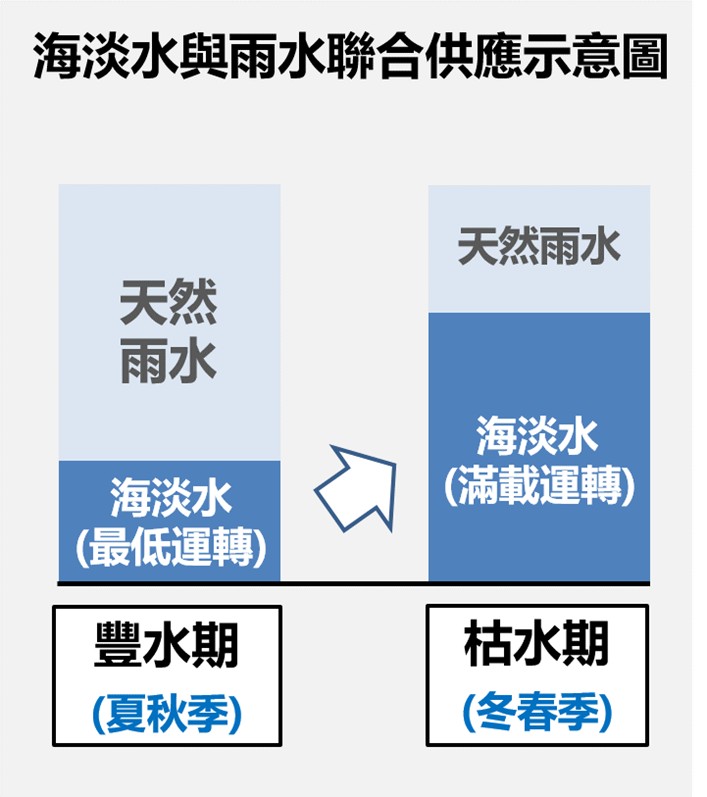Climate change is already a present reality. Following the most severe drought in a century in Taiwan in 2021, the southern region again experienced drought just two years later, highlighting the urgent need for backup water sources to strengthen water supply resilience. The Master Plan of Water Resources Management of Taiwan, approved in 2021, has identified technology-driven water generation as a key initiative, with the aim of securing additional backup water supplies (Fig. 1).
Technology-driven water generation mainly includes seawater desalination, reclaimed water, and the utilization of brackish water in tidal-affected reach. Among these, seawater desalination plants offer the advantages of being unaffected by rainfall, providing a stable supply, and being relatively quick to construct. Compared to reclaimed water, desalinated water can be directly incorporated into the public water supply system and jointly managed with regional water sources. This not only enhances water supply stability under intensified climate change but also reduces the risk of shortages during dry seasons.

Fig.1 Technological Enhancement of Water Production
Countries worldwide are actively constructing seawater desalination plants, with desalination technology already highly mature. Globally, there are more than 646 large-scale seawater desalination plants, each with a capacity of over ten thousand tons per day (Figs. 2 and 3). For example, Israel produces 675 million tons of desalinated water annually, accounting for more than 50% of its total water consumption. Similarly, Singapore’s five desalination plants produce 866,000 tons per day, covering more than 45% of its total water demand.

Fig.2 Global Distribution of Seawater Desalination Plants

Fig.3 Seawater desalination process
As of now, there are 25 completed and operational seawater desalination plants in Taiwan, with a total production capacity of about 45,000 tons per day, mostly located in offshore islands with relatively poor water availability. During the “century drought” in 2021, two emergency desalination units were completed on the main island: one in Hsinchu (13,000 tons/day) and one in Taichung (15,000 tons/day). Seawater desalination has since been incorporated into major strategies under the Water Resources Management Plan.
On April 27, 2023, the Executive Yuan approved desalination plant projects of 100,000 tons/day each in Hsinchu and Tainan (Phase I). The Water Resources Agency is expediting the projects, with production scheduled for 2027 in Hsinchu and 2028 in Tainan. During wet seasons, river and reservoir water will be prioritized, while desalination plants will maintain a minimal base-load output to reduce peak electricity demand in summer. In dry seasons, desalination plants will operate at full capacity, storing the produced water in reservoirs to enhance supply resilience and flexibility (see Figure 4).
In coordination with the Water Resources Agency, this branch is also carrying out planning and evaluation for desalination plants in Chiayi and Kaohsiung, with further promotion to be considered based on regional water supply and demand conditions.

Fig.4 Desalination water flexible operation strategy
The utilization of brackish water in tidal-affected reach is primarily considered based on the natural mixing of river flows and tides. Although some segments may have relatively higher salinity, their intake sources are comparatively stable, and the tidal ebb-and-flow facilitates water exchange in the river system, thereby reducing environmental impacts. As such, these areas possess development and utilization potential. Compared to seawater, brackish water resources in tidal reaches have lower salinity, and since they are not located directly along the coast, water conveyance pipelines can be shortened, reducing supply costs and further enhancing their value for evaluation and use.
The Water Resources Agency (WRA) has conducted planning and pilot assessments of modular desalination plants in the tidal-affected reach of the Zengwen River. However, due to significant variations in turbidity and total dissolved solids (TDS) in tidal river water quality, the stability of pretreatment and desalination facilities remains a concern. Additional testing and research are therefore required to improve water production efficiency and expand water resource utilization.
With respect to the promotion of reclaimed water, the Reclaimed Water Resources Development Act was enacted in May 2022. Under this Act, developers required to submit water use plans must incorporate a certain proportion of reclaimed water. In addition, according to Article 3 of the 2023 “Regulations on Developers’ Use of Reclaimed Water,” for development projects with planned water demand exceeding 20,000 CMD, at least 50% of industrial water use must be supplied from reclaimed water systems. At present, the WRA requires developers to prioritize the use of reclaimed water during the review of water use plans and will continue to enforce the mandated proportion of reclaimed water in the future.
To address intensifying climate change impacts and increasing industrial demand, it remains necessary to expand reclaimed water projects. The Ministry of Economic Affairs’ WRA will continue to collaborate with the Ministry of the Interior’s National Land Management Agency to advance this policy vision, targeting a reclaimed water supply of 1.32 million tons per day by 2031.